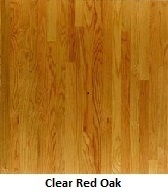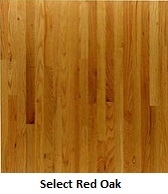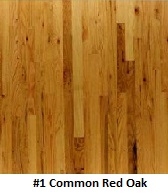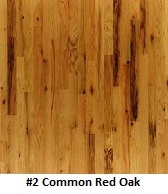"Appearance alone determines the grades of hardwood flooring since all grades are equally strong and serviceable in any application."
Red Oak and White Oak Flooring Grades
Below is the National Wood Flooring Association (NWFA) grade descriptions for Red Oak and White Oak and continuing down are the grade descriptions for other common domestic and exotic species.




Clear Oak - A flooring product of mostly heartwood with a minimum number of character marks and discoloration, providing a uniform appearance while allowing for all heartwood natural color variations. Will admit the following: 3/8" bright sapwood entire length of strip or equivalent if not extending further than 1" for 1/3 length of piece: small burls and fine pin worm holes; and equivalent characters such as small tight checks; in the absence if these, one thin brown streak 3" long to be allowed every 6'. Average length, bundled or nested, 3 1/2'.
Select Oak - A flooring product with coloration variations produced by differences of natural heartwood and sapwood, along with characters described. The face may contain: unlimited sound sapwood; slight imperfections in milling; a small tight knot every 3'; pin worm holes; burls and a reasonable amount of slightly open checks. Brown streaks should not extend the entire length of a piece. Two flag worm holes every 8' are permitted. Slight Imperfection in face work (torn grain) admitted. An intermittent, brown machine burn across the face not exceeding 1/4" width admitted. Also a slight quantity of bark on the back or sides admitted. Will admit pieces with 1/2" tongue. Spot filling is generally required for open characters. Average length, bundled or nested 3 1/4'.
# 1 Common Oak - A flooring product which contains prominent variations in coloration and varying characters. The following are not admitted: broken knots over 1/2" in diameter, large grub worm holes, and splits extending through the piece. Open characters such as checks and knot holes are admitted, but must be sound readily fill. Not more than 20" scant stock in thickness allowed every 5'. Minor imperfections in machining permitted. Shall admit sticker stain; varying wood characteristics, such as worm holes; and an occasional dark machine burn across the face not exceeding 1/2" wide, 1/64" deep and not more than two each 3'. 1/4" tongue allowed. Extremely dark pieces are not to be included. Average length, bundled or nested, 2 3/4'.
# 2 Common Oak - May contain sound natural variations of the forest product and manufacturing imperfections. The purpose of this grade is to furnish a floor suitable for homes, general utility use, of where character marks and contrasting appearance is desired. The following are not admitted: shattered or rotten ends, large broken knots, excessive bad millwork, shake, advanced rot, and similar unsound defects. Dark machine burns exceeding 3/64" deep not admitted. Knotholes and open characters, which will readily fill, are admitted. A limited number of pieces with no tongue which may be face nailed are admitted. Standard Packaging: Bundles to be 1 1/4" and longer; average length, bundled or nested, 2 1/4".
Domestic Hardwood Flooring Grades
Below is a general description of grades for other domestic species such as Walnut, Hickory, Maple, Ash, and American Cherry. For a more complete description please see actual products. This is meant only to give a general idea of each grade and not intended to be a complete list of all aspects of the grade. Grading can vary by species and manufacturing. Please contact us at 888-704-8778 for more information.
Select Grade - will have consistent color and grain variation throughout except for Maple and Hickory which can have clean heart and sap wood. Walnut will be mostly heartwood but will contain some sap wood. Almost completely free of knots and mineral streaks.
#1 Common Grade - contains more color and grain variation the select grade. Limited open character and will have some small knots and mineral streaks.
#2 Common Grade - will have more overall character than higher grades. Expect plenty of color variation, knots, mineral streaks and a shorter average board length. Hickory may contain "blue stain" (natural and normal fungus that grows on lumber giving it the appearance of having water spots, not a defect)
Character Grade - this grade is usually a mix of mostly #1 Common with some #2 Common. Great for those wanting the character look without being too rustic.
Exotic Flooring Grades
Grading of exotic species will be different than domestics. Please see below for a general description of the grading of exotic floors. For a more detailed description see product info or contact our sales team.
Clear Grade - Clear grade is the highest grade of exotic flooring. Depending on the species, exotic flooring is not usually uniform in color but clear grade will be the most uniform in appearance of color and grain. Clear grade will have the longest average board length and contain the least amount of natural imperfections among other grades. Exotic woods of all types are known for their beautiful color variation, and are appreciated for that reason. No matter what grade of this exotic flooring you choose, color variation from plank to plank will be present, although in Clear Grade the color variation will be to a lesser degree. Color variation is not considered a defect.
Select Grade - Select grade will have very similar aspects to clear grade but will for the most part just have more color variation from dark to light and colors present. Again color variation with exotic flooring is not a defect but rather a beautiful characteristic of the flooring.
Common Grade - Common grade in exotics is graded mainly for it's wide amount of color variation. One of the main reasons for this is the presence of sap wood. Also depending on the product it may contain some minor defects and possible shorter average board length.
Installation Considerations:
There are many types of hardwood floors to select from. Most have requirements for different areas of the house where they can be installed. Take note of moisture level and the sub floor material where the flooring will be installed. Solid hardwood floors are affected by moisture and tend to expand and contract when exposed to moisture. This is especially true for the 3/4" solid hardwood floors. The same is not so for engineered hardwood. Therefore solid wood flooring is not recommended to be installed in a basement or over a concrete slab. If you are building from the ground up (New Construction), design considerations must be taken into affect ahead of time if you plan to install hardwood over a concrete slab. Other types of hardwoods are stapled or nailed over a plywood sub floor. There are also glue down installations otherwise referred to as a "floating floor". While shopping for wood flooring be sure to understand where you are going to install your flooring determines what types of flooring options you will have.